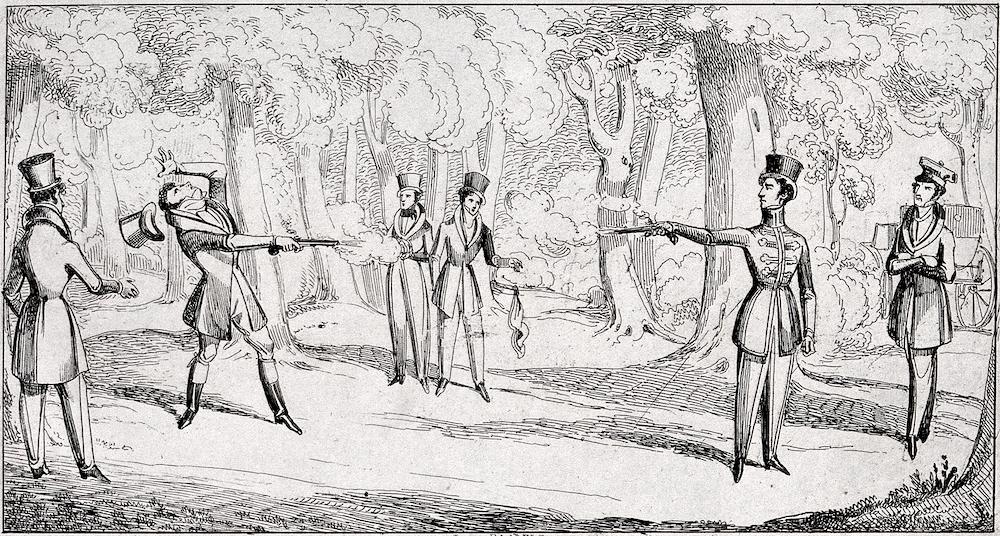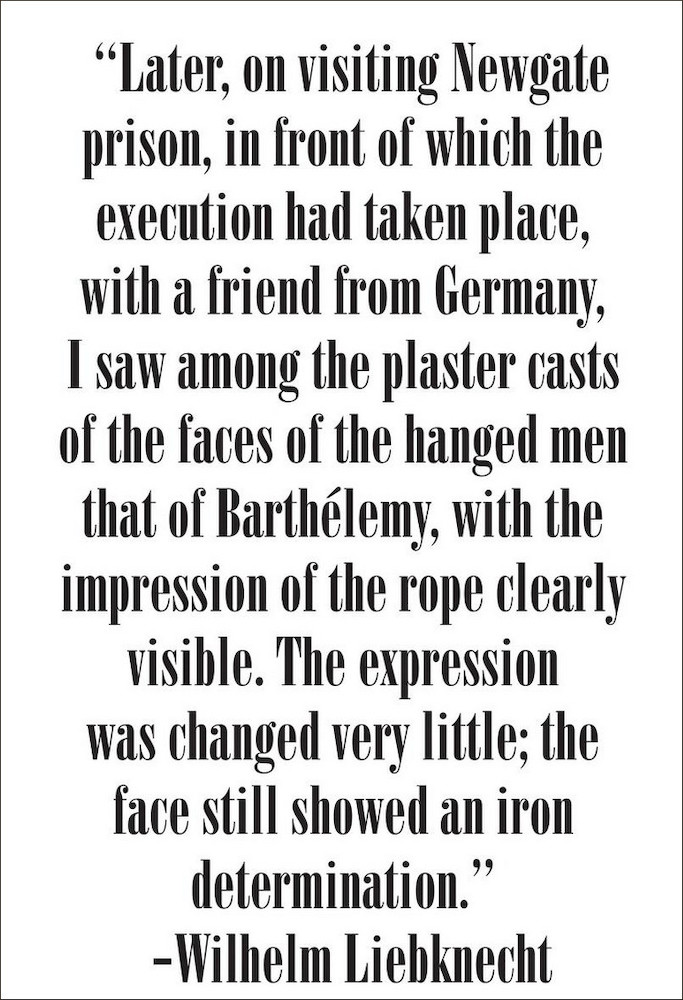This review is a version of one that first appeared in the Times Literary Supplement of 20 July 2018 (p.30). The author has extended and formatted it for the Victorian Web, adding illustrations, captions and links.

Cover of the book under review.
"Good God, I am shot!" cries greengrocer Charles Collard in Marc Mullholland's opening chapter (9). On the night of 8 December 1854, Collard, who had served with the East India Company army as well as with the police in Holborn, had been trying to stop someone fleeing a murder scene at 73 Warren Street. His wound proved fatal, but he survived long enough to identify the killer: a Frenchman, Emmanuel Barthélemy (1823-1855), who was subsequently hanged for his murder — although the original crime, a struggle culminating in the point-blank shooting of fizzy-drink manufacturer George Moore, was never brought to court mainly because of lack of witnesses. This tense opening chapter is our introduction to Barthélemy's biography, a real-life story that leads us through the menacing shadows of revolutionary Paris, and into the intrigues of a startlingly unfamiliar émigré London.

Rue St. Antoine barricade in Paris, 1848.
Source: Emmanuel Barthélemy, 13.
Barthélemy's background in France was working-class, but he was no common criminal. Since his teenage years, he had been a loyal if fiery-tempered follower of Auguste Blanqui (1805-1881), one of the leaders of the underground republican movement in Paris during the July Monarchy (the reign of Louis Philippe, from 1830-1848) and its violent aftermath. He had been imprisoned in the galleys in 1840 for shooting a police officer, and, not long after his release in March 1848, manned the barricades in his disappointment with the new Provincial Government. Despite fierce resistance, he was apprehended by the National Guard, and committed to military jail. He managed to get to London via Belgium in late 1849 after a daring, touch-and-go escape. As an inveterate republican, still bent on revolution, his experiences here were very different from those of the well-heeled royalists who had fled across the Channel in the wake of Louis Philippe — now living out his last days in exile as Queen Victoria's guest at Claremont in Surrey. For Barthélemy, England provided no such comfortable second home:
The streets heaved with people.... They were coming in from the rapidly expanding suburbs, where, as Charles Dickens disapprovingly noted [in Dombey and Son], "a disorderly crop of ... mean houses" were "rising out of the rubbish, as if they had been unskilfully sown there." Ladies swept about in long trailing dresses, shawls and poke bonnets. Mud on the ground meant that they wore boots nearly as large as those of men. In the late 1840s, many of the streets were being dug up to instal sewers and re-pave the roads with wooden blocks, which would eventually make the city a much more pleasant place in which to live. In the short run, however, it meant that the state of many of the capital’s roads was deplorable.... The river Thames stank — though the steamboats that ferried passengers across the river were nonetheless popular — and the open flame of coal gas-lamps, lighting streets and bridges, gave off a sickening smell.... Barthélemy walked these seemingly endless, poorly signposted streets in the greatest city in the world. [120-21]
Members of the French artistic community, like the sculptor Baron Marochetti, found new patrons in the sympathetic British aristocracy, and continued to live in some style during their exile. But, once safe in London, Barthélemy had no recourse but to take repetitive work in the burgeoning fashion industry. He was hired by a "Mr Coptel in Berners Street, working for about twelve months as a ‘mechanical steel staymaker,’ or corset-maker" (128). Mulholland again gives a compelling glimpse of London though the visitor's eyes: "The fashion for men in the 1850s was moving from colour — whites, greens, buffs and blues — to frock coats and waistcoats of sober black usually paired with checked or striped trousers held in tension by straps under the instep. Elegant women were wearing tight-laced corsets under panelled bodices, a short, tight jacket or shawl, and strikingly coloured skirts. It was observed that 'the gait of an Englishwoman is generally stiff and awkward, there being no bend or elasticity of the body on account of her stays'" (128). Coptel later claimed not to have liked his new workman, finding his countenance "very forbidding, his temper very violent, and his nature very revengeful" (128).
In London, Barthélemy mixed with the like-minded, and here Mulholland brings to life another side of life in the capital, one not usually explored. Soon after arrival, the black-haired revolutionary addressed the English Fraternal Democrats, with their ex-Chartist discontents, having been introduced to them as a hero of the barricades. Impatient with the notion of working towards long-term objectives, he was one of those, says Mulholland, "who wished to combine republicanism and socialism with strict revolutionary unity, discipline and bold action" (134). His ideas had much in common with those of Marx and Engels, and other German exiles then living in London, all of them wanting what Mulholland refers to as a "dictatorship of the proletariate" (137). He not only met and got to know and visit Karl and Jenny Marx, but even gave Karl some fencing lessons. But, as a Blanquist, his desire to seize power was more urgent. With this strong impulse to action, in December 1850 Barthélemy risked returning to France, attempting to arrange the escape of six prisoners, including his revolutionary hero, Blanqui himself, from a prison island off Brittany. With incredible daring, he even successfully infiltrated the jail, disguised as a priest. On his return, Barthélemy took a new job working for ill-fated Moore on his fizzy drink machines.

Two gentlemen duelling with pistols; an etching
of 1823 in the Wellcome Collection,
ref. 5686681 (public domain).
Mulholland tells the ins-and-outs of his story with aplomb, bringing to murky life the two great capital cities of that time, and pointing up their differences: the seething mix of rich and poor in Paris, the sharp division between them in London, the "heady swirl of subversion" in Paris (28), the intrigues and in-fighting of the London émigrés. It was the latter that led to the exploit for which Barthélemy is best remembered here: his duel in October 1852 near Englefield Green, Surrey, against Frederic Cournet. A follower of a different faction, Cournet had been spreading slander about his private life. This was not to be borne. An appeal for help was made to Guiseppe Mazzini, the Italian revolutionary then exiled in London, but it was too late to intervene, and arrangements for the duel were set in motion. For Barthélemy, this was not an exceptional event. He had been involved in a double duel in the autumn of 1850, albeit an affair that took place more circumspectly on a brief excursion to Belgium. On that occasion, his own opponent had not turned up, and the second duel, for which he was one of the seconds, ended in injury rather than death. In fact, "[i]t was quite rare for a duel to end in loss of life," says Mulholland. "An authority calculated that of two hundred duels in Britain, only one in fourteen ended in fatality" (202). This time, there was to be only the one engagement, in which Barthélemy would participate as a principal. Two seconds were appointed on each side, and weapons chosen — again, as was normal by this date, pistols. However, there were complications: suspicions that Barthélemy's gun had been tampered with, and an issue about the number of paces each man advanced. For whatever reason, in the end, Cournet became another of Barthélemy's victims — making this both the last duel on English soil and the last fatal one. Barthélemy and three of the seconds were apprehended and tried, but got off lightly. Duelling still had a whiff of the traditional "defence of honour" about it, although this controversial case effectively put an end to the custom. After a short prison sentence for manslaughter, Barthélemy was free to continue his intrigues.

Source: Emmanuel Barthélemy,
facing Contents.
At the time of the sordid events of 1854 with which the book opens, he was apparently planning the assassination of Napoleon III. We will never know whether or not the shooting of greengrocer and ex-policeman Collard was accidental, as one witness believed. The crime scene from which Barthélemy was fleeing is also shrouded in mystery, although the most likely explanation is that he had been trying to extort funds from Moore for his expedition. But, whatever the exact circumstances, he could not in the end escape being publicly hanged at Newgate. The German socialist and friend of Marx, Wilhelm Liebknecht, whose years of exile in London overlapped with Barthélemy's, noted his resolution in the face of death. Victor Hugo painted a grimmer picture of the Frenchman in Les Misérables, describing him as "sallow-faced and taciturn, a sort of tragic outcast" (qtd. in Mulholland 174), a description that Mulholland finds unfair in several points. But readers are still unlikely to share the biographer's fascination with his subject. Rather, they may agree with the dying Collard, who turned away from him, saying "Oh, you cruel man!" (10).
Link to related material
Bibliography
[Book under review] Mulholland, Marc. The Murderer of Warren Street: The True Story of a Nineteenth-Century Revolutionary. London: Hutchinson, 2018. 372 + xi pp. Hardback. IBN 9781786331137. £16.99.
[Source of illustrations] Emmanuel Barthélemy. Pamphlet with the imprint Crimethinc. Internet Archive Python Library. Web. 4 November 2021.
Created 4 November 2021